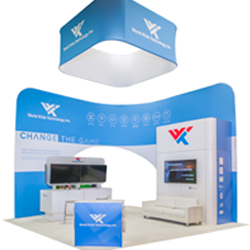Fabric Structures
 We're about to invest in a handful of fabric exhibit components, particularly because of their minimal weight and easy handling. What types of fabric structures are available? We're about to invest in a handful of fabric exhibit components, particularly because of their minimal weight and easy handling. What types of fabric structures are available?
 Like a corseted gown, exhibit fabric can't stand upright by itself; it needs a structural or framing system to support it. Thus, you can categorize almost all fabric components according to the type of structure - typically comprising anodized or powder-coated aluminum tubing, polycarbonate rods, extruded PVC piping, or round or square steel rods - used to support them. Here, then, is a brief description of the four types of fabric structures. Like a corseted gown, exhibit fabric can't stand upright by itself; it needs a structural or framing system to support it. Thus, you can categorize almost all fabric components according to the type of structure - typically comprising anodized or powder-coated aluminum tubing, polycarbonate rods, extruded PVC piping, or round or square steel rods - used to support them. Here, then, is a brief description of the four types of fabric structures.
 "Pillowcased" - Two layers of fabric are sewn together to create a sort of pillowcase, which is then slipped over a frame and secured together via zippers, snaps, hook-and-loop-fasteners, etc. Fabrics also can be pillowcased to create tensioned and nontensioned components. "Pillowcased" - Two layers of fabric are sewn together to create a sort of pillowcase, which is then slipped over a frame and secured together via zippers, snaps, hook-and-loop-fasteners, etc. Fabrics also can be pillowcased to create tensioned and nontensioned components.
 Pole and Pocket - Suppliers sew a pocket into one or more edges of the fabric, and then slide a lightweight pole into it. By securing the pole to another structure, e.g., an existing aluminum frame, a wall, the floor, etc., you can then stretch the fabric taught or drape it. Pole and Pocket - Suppliers sew a pocket into one or more edges of the fabric, and then slide a lightweight pole into it. By securing the pole to another structure, e.g., an existing aluminum frame, a wall, the floor, etc., you can then stretch the fabric taught or drape it.
 Silicone-Edge Graphics (SEG) - This system features an aluminum extrusion/frame with a groove or channel, which is paired with a fabric featuring a strip of silicone sewn onto its edges. The silicone is then slipped into the groove on the aluminum frame
to secure it and create a wrinkle-free, taut display with finished edges. Silicone-Edge Graphics (SEG) - This system features an aluminum extrusion/frame with a groove or channel, which is paired with a fabric featuring a strip of silicone sewn onto its edges. The silicone is then slipped into the groove on the aluminum frame
to secure it and create a wrinkle-free, taut display with finished edges.
 Fabric Only - In some instances, fabric can be attached to a stationary object, such as a freestanding column or ceiling truss, via wires or other devices and then pulled taut. Since exhibitors can't typically attach anything to venue elements, a special structure is usually built and the fabric is attached to it and stretched from it. Fabric Only - In some instances, fabric can be attached to a stationary object, such as a freestanding column or ceiling truss, via wires or other devices and then pulled taut. Since exhibitors can't typically attach anything to venue elements, a special structure is usually built and the fabric is attached to it and stretched from it.
As you might guess, each type of component has its benefits and drawbacks. But given the flexibility and weight-related benefits of fabric components, surely one of these options will be a wise investment for your exhibit program.
- Leo Boczar, director of communication, Fabric Images Inc., Elgin, IL
|






 We're about to invest in a handful of fabric exhibit components, particularly because of their minimal weight and easy handling. What types of fabric structures are available?
We're about to invest in a handful of fabric exhibit components, particularly because of their minimal weight and easy handling. What types of fabric structures are available? Like a corseted gown, exhibit fabric can't stand upright by itself; it needs a structural or framing system to support it. Thus, you can categorize almost all fabric components according to the type of structure - typically comprising anodized or powder-coated aluminum tubing, polycarbonate rods, extruded PVC piping, or round or square steel rods - used to support them. Here, then, is a brief description of the four types of fabric structures.
Like a corseted gown, exhibit fabric can't stand upright by itself; it needs a structural or framing system to support it. Thus, you can categorize almost all fabric components according to the type of structure - typically comprising anodized or powder-coated aluminum tubing, polycarbonate rods, extruded PVC piping, or round or square steel rods - used to support them. Here, then, is a brief description of the four types of fabric structures. 


